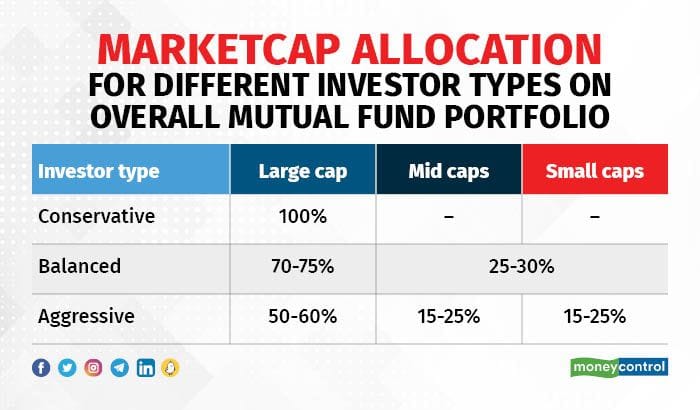Mutual funds
While there are several equity fund categories, investors often look at their mutual fund (MF) portfolio from the lens of marketcap. That is, which market (cap) segment has how much exposure in their portfolios.
The Securities and Exchange Board of India (SEBI) has very clearly defined three market-cap segments and stocks.
• Largecap: Stocks ranked 1-100 by market capitalisation
• Midcap: Stocks ranked 101-250 by marketcap
• Smallcap: Stocks ranked 251 onwards by marketcap
Companies in different market segments (and having different sizes) tend to have different growth prospects and return potential. Given the higher risks, smallcaps also tend to have a higher return potential (but not a guarantee). Also, by nature, largecaps tend to be much less volatile than mid and small caps. Smallcaps are the most volatile.
Now, let us look at the actual question.
How much to allocate to large, mid and smallcaps?
Different people will have different opinions on how to build an MF portfolio and how much to allocate to different segments. But given the nature of stocks in different marketcaps and their risk-return profiles, the allocation will definitely vary for investors of different risk profiles.
So, here is what can be taken as broad pointers:
• Conservative investors: These investors, anyways, have a very small allocation to equity. So, the entire allocation to equity can be made to 100 percent largecaps alone. This can be achieved by investing in passive largecap funds, active largecap funds, and flexicap funds, with predominant allocation to largecaps.
• Balanced investors: A balanced investor can consider some exposure to non-largecaps. So, about 70-75 percent to largecaps and the remaining 25-30 percent in midcaps and smallcaps can be considered. This can be achieved by having a mix of largecap funds, flexicap funds and large & midcap funds. There is no dire need to have standalone mid or smallcap funds as the required 25-30 percent exposure to mid and smallcaps can be managed easily via flexicap/large&midcap funds allocation to these market segments.
• Aggressive investors: An aggressive investor can consider about 50-60 percent allocation to largecaps, 15-25 percent to midcaps and the remaining 15-25 percent to smallcaps. This can be achieved by having a mix of largecap funds, flexicap/large&midcap funds, midcap funds and smallcap funds.
The above allocations are general suggestions. Each investor’s unique risk appetite, requirements and goals may demand a different approach.

Compared to funds that invest in largecap stocks, those that invest in mid and smallcap stocks usually exhibit greater volatility. While largecap stocks are extensively tracked, there is a chance to find less-known stocks in the mid and smallcap categories that have the potential to generate significant returns.
As a result of these factors, small and midcap funds carry a higher risk premium and can offer higher returns than largecap funds, as demonstrated historically. But this comes with additional volatility and risk.
Many times, investors are tempted by recent performances and may choose to invest heavily in smallcap funds but that is not the right approach. One should invest in these funds only if the associated risk is properly understood and one has the patience to stay invested for longer investment horizons of seven or more years.
Therefore, the riskier buckets should only be allocated a small portion of the portfolio, and, hence, for most investors, the total allocation to mid and smallcaps should be limited to a maximum of 30-35 percent of the portfolio.
One thing to note here is that we are talking about exposure to marketcap segments and not just MF categories. Different fund categories have different investment mandates due to which they need to invest a certain minimum portion in a given market segment.
• A largecap fund needs to invest at least 80 percent of assets in largecap stocks.
• A large and midcap fund needs to invest at least 35 percent each in large and midcap stocks.
• Midcap and smallcap funds need to invest at least 65 percent in midcap and smallcap stocks, respectively.
• A flexicap fund has the freedom to invest anywhere, and, hence, different schemes in the flexicap category will have different allocations to large/mid/smallcap stocks (Check here).
So when looking at an overall portfolio made up of several funds, you need to aggregate the marketcap allocations of all funds.
Disclaimer: The views should not be considered professional investment advice, advertisement or otherwise. No specific product/service recommendations have been made and the article itself is for general educational purposes only. Readers are requested to take into consideration all risk factors, including their financial condition, suitability to risk-return profile and the like and take professional investment advice before investing.